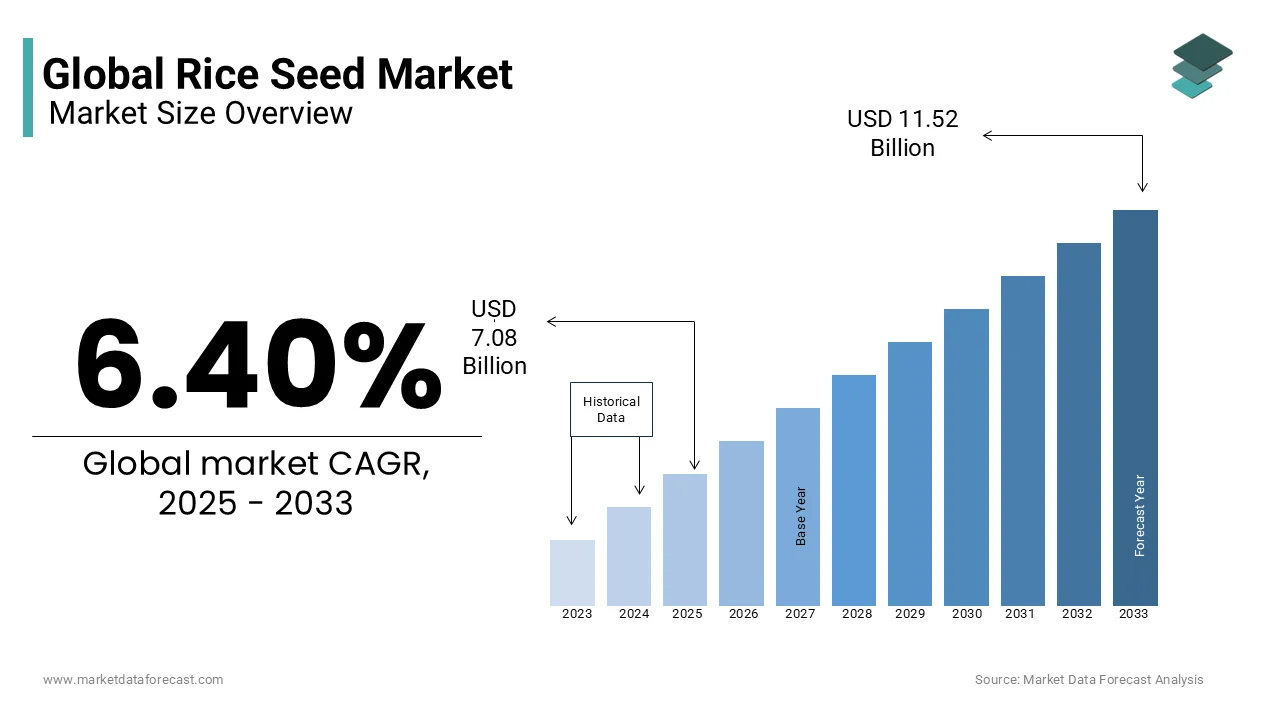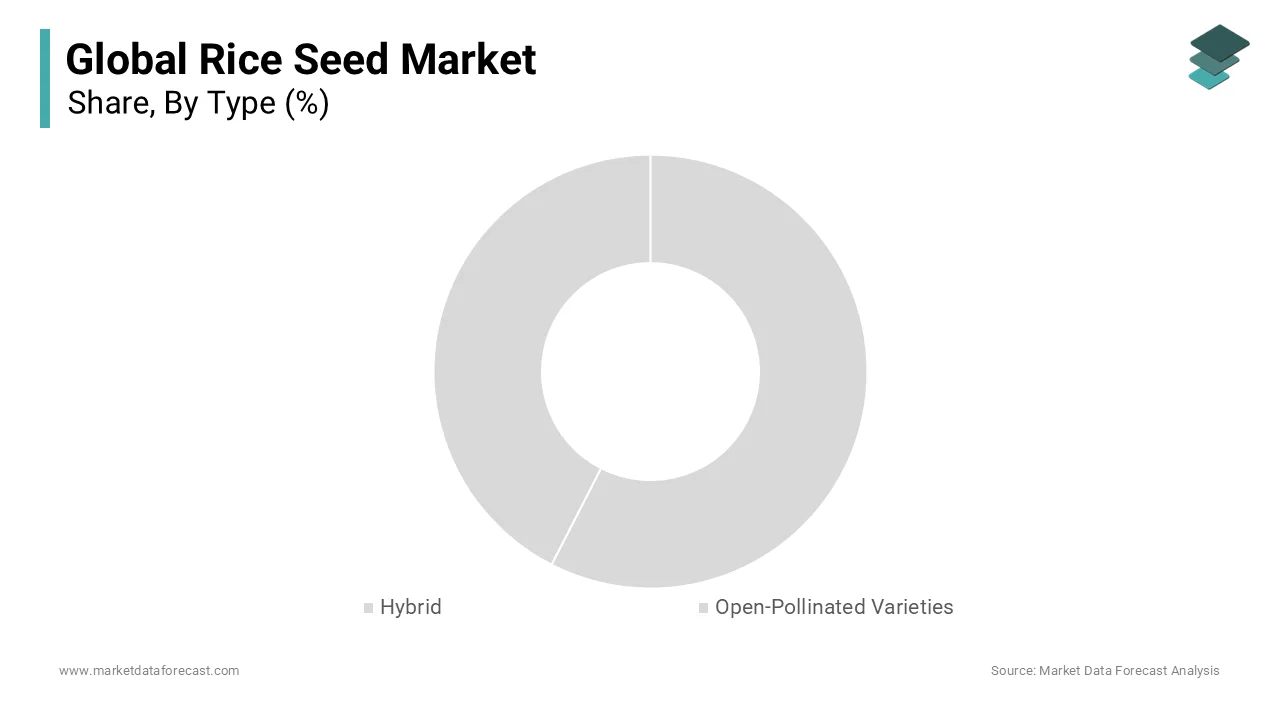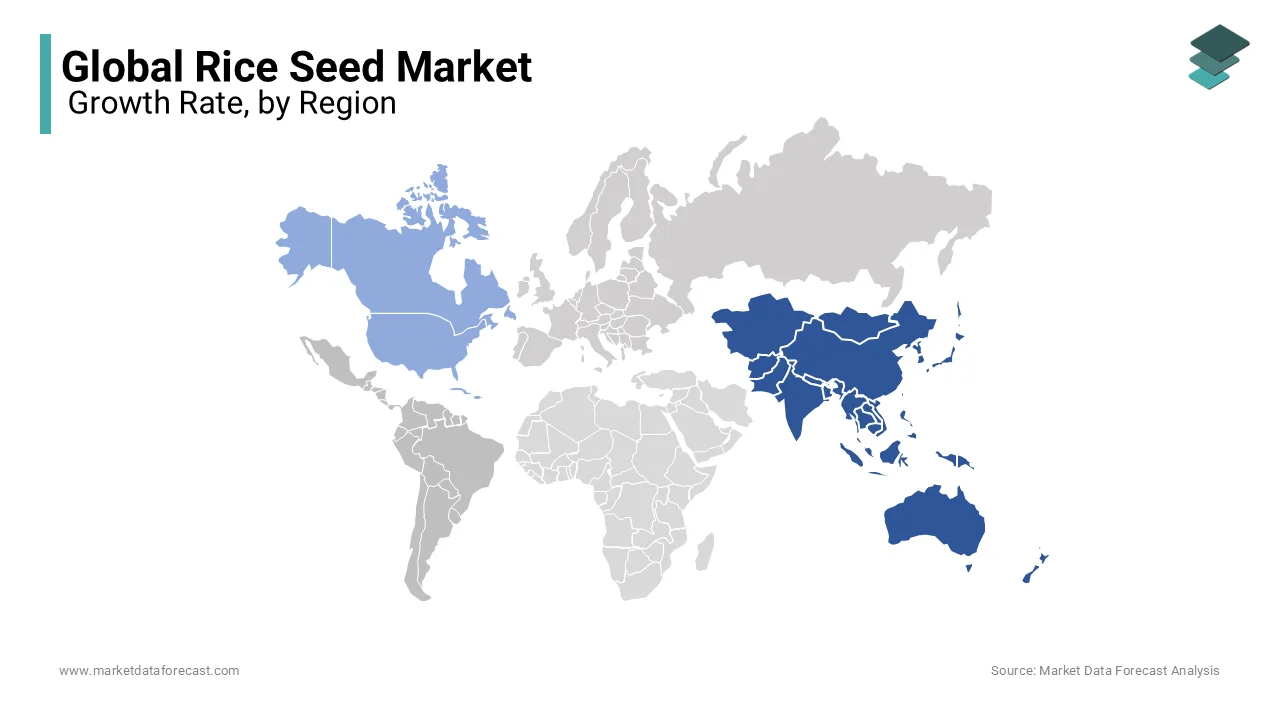Global Rice Seed Market Size, Share, Trends, Covid-19 Impact and Growth Analysis Report – Segmented By type (hybrid and Open-Pollinated Varieties), Grain Size (Long, Medium and Short), Hybridization Technique (Two-Line and Three-Line), Treatment (Treated and Untreated Seeds) and Region (North America, Europe, Latin America, Asia Pacific, Middle East And Africa) - Industry Analysis From (2025 to 2033)
Global Rice Seed Market Size
The global rice seed market was valued at USD 6.65 billion in 2024 and is anticipated to reach USD 7.08 billion in 2025 from USD 11.52 billon by 2033, growing at a CAGR of 6.40% during the forecast period from 2025 to 2033.

The benefits associated with adopting commercial rice seed are an important factor contributing to the expansion of this market worldwide. The economic expansion of rice seed in developing countries and increased R&D spending in the agricultural sector are stimulating the growth of this market. Farmers have received immense support from government and private institutions. The immediate availability of agricultural credit, fertilizers, pesticides, contract services, and machinery has led to increased production to meet the growing call. Farmers have also adopted knowledge-intensive technologies in addition to supporting government and non-profit organizations in the form of technical knowledge required for better crop management practices and better yields.
As a cereal, rice is the staple food most consumed by much of the world's human population, especially in Africa and Asia. Quality seeds are very important to increase production. Maintaining varietal purity of seeds and controlling seed-borne diseases is necessary for the production of high-quality seeds. Rice seeds are produced using techniques such as a two-line system and a three-line rice seed production system. Rice seeds are available in untreated and processed forms, where processed rice seeds are widely employed by the pharmaceutical industry. Drugs made from rice seeds are supposed to be new edible drug treatments. Additionally, rice is a good source of B vitamins, as well as an excellent source of minerals such as magnesium and manganese. Where brown rice contains a high proportion of vitamins and oxidants, while white rice contains phosphorus, thiamine, selenium, folic acid, omega-6 fatty acids, and niacin.
Market Drivers
Continual technological advances in molecular biology, genomics, and biotechnology have led to developments in hybrid rice breeding. This is predicted to drive the expansion of the worldwide rice seed market. Farmers in the Asia-Pacific region make extensive use of the hybrid rice production system which has led to an increase in the production of hybrid rice seed in this region. The main rice seed companies are expanding their activities in Asian countries. Strong government support for hybrid seed subsidies has encouraged farmers to adopt hybrid breeding technology in developing countries. Also, reduced prices of hybrid rice seeds to bridge the gap between open-pollinated varieties and hybrid seeds allow major players to invest in developing markets. Countries such as India, China, Thailand, and Vietnam dominate the global rice seed market in the Asia Pacific due to the high production of open-pollinated varieties and hybrid rice seeds. The main rice seed companies are expanding their activities in Asian countries.
Market Restraints
A steadily burgeoning population and a shortage of growing areas are the two main factors that will act as constraints and further challenge the development of the rice seed market during the projection period.
Market Opportunities
Currently, the world market for rice seeds is dominated by open-pollinated rice varieties. However, the increasing adoption of hybrid rice seed cultivation and the falling price of hybrid rice seed are predicted to drive the expansion of the worldwide rice seed market. The benefits of adopting commercial rice seed are an important factor in the expansion of the rice seed market, along with the growing call for naturally grown rice, increased technology, and advances in seed production. The growing call for organic food products around the world will create new opportunities for the rice seed market during the foreseen period 2022 - 2027.
Market Challenges
Government regulations on genetic modification are likely to hamper profit limits in this industry in the coming days.
Impact of COVID-19 on the Rice Seed Market
Coronavirus is the biggest public health crisis of the 21st century to date. Policies and programs to contain COVID-19 have also had massive secondary economic and social effects worldwide. The endemic has impacted millions of lives across the globe. Initially, all the countries of the world announced the blockade for a month, which greatly affected trade in agricultural products. Rice seed manufacturing companies face a shortage of raw materials due to supply chain and transport disruption. Farmers also faced difficulties with the rice harvest due to a lack of labor during the blockade period. Then, after the government authorized trade-in essential and agriculture-related products, it normalized the expansion of the worldwide rice seed market.
REPORT COVERAGE
|
REPORT METRIC |
DETAILS |
|
Market Size Available |
2024 to 2033 |
|
Base Year |
2024 |
|
Forecast Period |
2025 to 2033 |
|
CAGR |
6.40% |
|
Segments Covered |
By type, grain size, hybridization techniques, and Region |
|
Various Analyses Covered |
Global, Regional & Country Level Analysis, Segment-Level Analysis, DROC, PESTLE Analysis, Porter’s Five Forces Analysis, Competitive Landscape, Analyst Overview on Investment Opportunities |
|
Regions Covered |
North America, Europe, APAC, Latin America, Middle East & Africa |
|
Market Leaders Profiled |
Bayer (Germany), DowDuPont (US), Syngenta (Switzerland), Advanta Seeds (UPL) (India), and Nuziveedu Seeds (India) |
SEGMENTAL ANALYSIS
Global Rice Seed Market By Type
Hybrid products accounted for the largest revenue share of over 70.0% in 2024. The escalating popularity of crossbreed categories due to multiple benefits such as improved yield, vigor, and disease and pest resistance is supposed to have a positive impact on the expansion segment.

Global Rice Seed Market By Grain Size
Medium-sized cereals had the largest revenue share of nearly 50% in the rice seed market in 2018. These variants grow two to three times their width and are moist, tender, and slightly chewy.
REGIONAL ANALYSIS
The Asia Pacific region has the largest share of the global rice seed market due to the high production and consumption of rice. North America is likely to have the second-largest share of the world market. The growing adoption of commercial hybrid seeds and open-pollinated varieties over farm-saved seeds has contributed to the expansion of the world market for Rice Seed. The Latin America, Middle East, and Africa regions are anticipated to post a healthy expansion rate during the conjecture period of the worldwide market. Rice is an important staple food in the Asia-Pacific region and is largely produced and consumed throughout the region. This area is characterized by a high population density that is constantly escalating, especially in countries like India and China. In addition to this, about a quarter of the population residing in Asian countries falls under the category of poor.

These countries are anticipated to boost rice consumption in Asia-Pacific countries. However, in countries like Japan and South Korea, where incomes are quite high, per capita rice consumption has started to decline. The constantly growing population and the scarcity of growing areas are two of the main problems to be addressed in the worldwide rice seed market. Increasing the productivity of rice cultivation is absolutely necessary to meet the growing needs of the Asia Pacific region. South America and Africa are the other two regions included in the rice seed business. Farmers in these areas must be motivated to use quality seeds obtained from organized seed production, rather than seeds stored on the farm.
KEY MARKET PLAYERS
The global market for Rice Seed is dominated by key players such as Bayer (Germany), DowDuPont (US), Syngenta (Switzerland), Advanta Seeds (UPL) (India), and Nuziveedu Seeds (India). Some of the emerging players in the Rice Seed market include Mahyco (India), BASF (Germany), Kaveri Seeds (India), SL Agritech (Philippines), Rasi Seeds (India), Rallis (India), JK Seeds (India), Hefei Fengle (China), LongPing (China), Guard Agri (Pakistan), and National Seeds Corporation (India).
RECENT HAPPENINGS IN THIS MARKET
Corteva Agriscience, the agricultural division of DowDupont, announced that it would make its Brevant hybrid Rice Seed available to Indian farmers.
Bayer has launched a one-of-a-kind hybrid rice seed, Arize AZ 8433 DT, with high intrinsic tolerance to brown hop (BPH) and bacterial leaf blight (BLB).
MARKET SEGMENTATION
This research report on the global rice seed market is segmented and sub-segmented into the following categories.
By Type
- Hybrid
- Open-Pollinated Varieties
By Grain Size
- Long
- Medium
- Short
By Hybridization Techniques
- Two-line
- Three-line
By Region
- North America
- Europe
- Asia Pacific
- Latin America
- Middle East & Africa
Frequently Asked Questions
What is the current size of the global rice seed market?
The market is valued in the billions and is expected to grow due to rising demand for rice, especially in Asia-Pacific.
What factors drive the growth of the rice seed market?
Population growth, climate resilience, hybrid seed adoption, and government support are key drivers.
Which regions dominate the rice seed market?
Asia-Pacific (China, India, Indonesia, Vietnam) leads, followed by Africa and Latin America.
What are the major trends in the rice seed industry?
Growth in hybrid & genetically modified (GM) seeds, increased mechanization, and focus on high-yield & drought-resistant varieties.
Who are the key players in the market?
Major companies include Bayer, Syngenta, Corteva, Advanta Seeds, and Nuziveedu Seeds.
Related Reports
Access the study in MULTIPLE FORMATS
Purchase options starting from
$ 2500
Didn’t find what you’re looking for?
TALK TO OUR ANALYST TEAM
Need something within your budget?
NO WORRIES! WE GOT YOU COVERED!
Call us on: +1 888 702 9696 (U.S Toll Free)
Write to us: sales@marketdataforecast.com